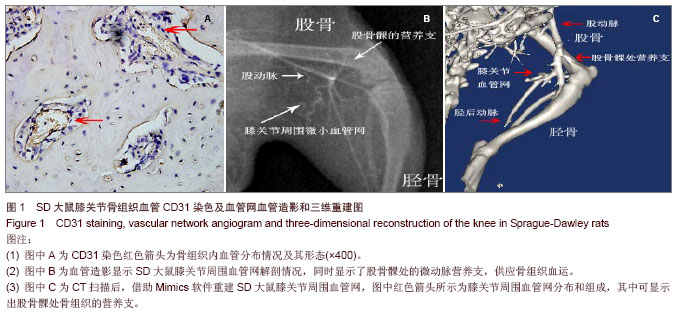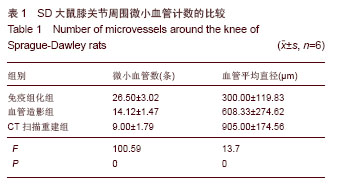| [1]He X, Dziak R, Yuan X, et al. BMP2 genetically engineered MSCs and EPCs promote vascularized bone regeneration in rat critical-sized calvarial bone defects. PLoS One. 2013;8(4): e60473. PMID:23565253 [2]Carano RA, Filvaroff EH. Angiogenesis and bone repair. Drug Discov Today. 2003;8 (21):980-989.[3]Kanczler JM, Oreffo RO. Osteogenesis and angiogenesis: the potential for engineering bone. Eur Cell Mater. 2008;15:100- 114.[4]曾启龙,牡丹,施健.不同模式减影血管造影遥控对比剂跟踪技术应用[J]. 浙江临床医学,2010,12(5):461-463.[5]李洁羽,叶韵斌,陈淑萍,等.三种标记法对脐血CD34^+造血干细胞绝对计数的比较分析[J].中华检验医学杂志,2007,30(3): 348-350.[6]Westerlaan HE, van Dijk JM, Jansen-van der Weide MC, et al. Intracranial aneurysms in patients with subarachnoid hemorrhage: CT angiography as a primary examination tool for diagnosis--systematic review and meta-analysis. Radiology. 2011;258(1):134-145. [7]McKinney AM, Palmer CS, Truwit CL, et al. Detection of aneurysms by 64-section multidetector CT angiography in patients acutely suspected of having an intracranial aneurysm and comparison with digital subtraction and 3D rotational angiography. AJNR Am J Neuroradiol. 2008 ; 29(3):594-602. [8]Iyyampillai G, Raman ET, Rajan DV, et al. Determinants of Femoral Tunnel Length in Anterior Cruciate Ligament Reconstruction: CT Analysis of the Influence of Tunnel Orientation on the Length. Knee Surg Relat Res. 2013; 25(4):207-214.[9]Walsh DA, McWilliams DF, Turley M J, et al. Angiogenesis and nerve growth factor at the osteochondral junction in rheumatoid arthritis and osteoarthritis. Rheumatology (Oxford). 2010;49(10):1852-1861.[10]Ellabban AS, Kamel SR, Ahmed SS, et al. Receptor activator of nuclear factor kappa B ligand serum and synovial fluid level. A comparative study between rheumatoid arthritis and osteoarthritis. Rheumatollnt. 2012;32(6):1589-1596.[11]李涛,崔惠勤. 膝关节髌下脂肪垫区滑膜病变的MRI诊断[J]. 影像诊断与介入放射学,2012,21(3):201-204.[12]李锐,郭燕丽. 类风湿性关系炎膝关节滑膜及血管增殖的高频超声研究[J]. 中华超声影像学杂志,2000,9(9):53-555.[13]王簕,裴国献,高梁斌,等. 血管化组织工程骨修复兔股骨干骨缺损[J]. 中华医学杂志,2010,90(23):1637-1641. [14]Wang L, Fan H, Zhang ZY, et al. Osteogenesis and angiogenesis of tissue-engineered bone constructed by prevascularized β-tricalcium phosphate scaffold and mesenchymal stem cells. Biomaterials. 2010;31(36): 9452-9461.[15]Kneser U, Schaefer DJ, Polykandriotis E,et al. Tissue engineering of bone: the reconstructive surgeon's point of view. J Cell Mol Med. 2006;10(1):7-19.[16]Zhou J, Lin H, Fang T,et al. The repair of large segmental bone defects in the rabbit with vascularized tissue engineered bone. Biomaterials. 2010;31(6):1171-1179. [17]Tsigkou O, Pomerantseva I, Spencer JA, et al. Engineered vascularized bone grafts. Proc Natl Acad Sci U S A. 2010; 107(8):3311-3316. [18]Buschmann J, Welti M, Hemmi S, et al. Three-dimensional co-cultures of osteoblasts and endothelial cells in DegraPol foam: histological and high-field magnetic resonance imaging analyses of pre-engineered capillary networks in bone grafts. Tissue Eng Part A. 2011;17(3-4):291-299.[19]赵震宇,邵林,刘建宇,等.新型外固定器制作大鼠负重骨节段性骨缺损模型的实验研究[J].中华创伤骨科杂志,2010,12(12): 1160-1163. [20]张余,尹庆水,徐国洲,等.复合珊瑚羟基磷灰石人工骨异位成骨效应的实验研究[J].实用医学杂志,2002,18(5):458-461.[21]谢能峰,苏伟,李尚政,等.膝后主要血管神经束的MRI定位及临床意义[J].广东医学,2013,34(9):1359-1361.[22]赵绵松,夏蓉晖,王玉华,等.骨关节炎与类风湿关节炎患者膝关节滑膜中血管内皮生长因子及血管形态的特征[J].北京大学学报:医学版,2012,44(6):927-931.[23]邹仲之.组织学与胚胎学[M].5版.北京:人民卫生出版社,2001: 107.[24]Zou D, Zhang Z, He J, et al. Blood vessel formation in the tissue-engineered bone with the constitutively active form of HIF-1α mediated BMSCs. Biomaterials. 2012;33(7): 2097- 2108. [25]Beier JP, Hess A, Loew J, et al. De novo generation of an axially vascularized processed bovine cancellous-bone substitute in the sheep arteriovenous-loop model. Eur Surg Res. 2011;46(3):148-155. [26]Cedola A, Campi G, Pelliccia D,et al. Three dimensional visualization of engineered bone and soft tissue by combined x-ray micro-diffraction and phase contrast tomography. Phys Med Biol. 2014;59(1):189-201. [27]Liu FY, Wang MQ, Fan QS, et al. Clinical application of the three-dimensional CT of the flat-panel digital subtraction angiography system. Nan Fang Yi Ke Da Xue Xue Bao. 2009; 29(2):298-300.[28]Lu L, Zhang LJ, Poon CS, et al. Digital subtraction CT angiography for detection of intracranial aneurysms: comparison with three-dimensional digital subtraction angiography. Radiology. 2012;262(2):605-612.[29]Götz W, Reichert C, Canullo L, et al. Coupling of osteogenesis and angiogenesis in bone substitute healing - a brief overview. Ann Anat. 2012;194(2):171-173.[30]Pal A, Clarke JM, Cameron AE. Case series and literature review: popliteal artery injury following total knee replacement. Int J Surg. 2010;8(6):430-435. [31]解先宽,李杭,郑强,等. 膝关节周围骨折、脱位伴血管损伤的诊疗分析[J]. 中华外科杂志,2009,47(23):1794-1797.[32]Lewis RA. Medical phase contrast x-ray imaging: current status and future prospects. Phys Med Biol. 2004;49(16): 3573-3583.[33]Matsuki M, Kani H, Tatsugami F, et al. Preoperative assessment of vascular anatomy around the stomach by 3D imaging using MDCT before laparoscopy-assisted gastrectomy. AJR Am J Roentgenol. 2004;183(1):145-151. [34]Miyaki A, Imamura K, Kobayashi R, et al. Preoperative assessment of perigastric vascular anatomy by multidetector computed tomography angiogram for laparoscopy-assisted gastrectomy. Langenbecks Arch Surg. 2012;397(6):945-950.[35]范猛,汪爱媛,王玉,等. 基于Micro-CT的骨内微血管显影和三维重建[J]. 南开大学学报:自然科学版,2011,44(1):78-84.[36]Patel PA, Chen W, Wilkening MW, et al. Extended composite temporoparietal fascial flap: clinical implications for tissue engineering in mandibular reconstruction. J Craniofac Surg. 2013;24(1):273-277. [37]Scala M, Gipponi M, Pasetti S, et al. Clinical applications of autologous cryoplatelet gel for the reconstruction of the maxillary sinus. A new approach for the treatment of chronic oro-sinusal fistula. In Vivo. 2000;21(3):541-547. [38]王健明,孙富广,朱文彬,等. 64层螺旋CT血管成像及三维重建后处理技术对活体供肾血管的评估[J]. 中华移植杂志(电子版), 2013,7(2):6-9.[39]李雪萍,刘彪,黄波,等. 16层螺旋CT肺血管造影及三维重建技术在肺癌血供诊断中的价值[J]. 中国肿瘤临床与康复,2013, 14(5): 495-497.[40]李国策,王志铭,雷振,等.正常犬肺动脉三维CT重建中不同剂量对比剂的比较[J].中国组织工程研究与临床康复,2011,15(4): 671-674.[41]谷建伟,张丽,陈志强,等.基于投影的CT图像金属伪影非线性权重校正[J].清华大学学报:自然科学版,2006,46(6):825-828.[42]陈利帮,陈春.腰椎椎弓根螺钉双皮质固定的椎前大血管三维重建的解剖学研究[J].中国临床解剖学杂志,2013,31(5):528-535.[43]刘军伟,位思荣,侯鲁强,等.旋转三维数字减影血管成像在腹部介入治疗中的应用[J].实用医药杂志,2013,30(8):707-707.[44]余元新,梁长虹,张忠林,等.多层螺旋CT肾动脉成像的图像后处理技术及临床应用[J].影像诊断与介入放射学,2005,14(2): 96-98.[45]赵宏亮,石明国,宦怡,等.先心病双源CT血管造影前瞻性序列扫描与大螺距扫描的对照研究[J].中华放射医学与防护杂志, 2013,33(5):555-558.[46]Katzberg RW, Newhouse JH. Intravenous contrast medium-in-duced nephrotoxicity: is the medical risk really as great as we have come to believe? Radiology. 2010; 256(1): 21-28.[47]Hunsaker AR, Oliva IB, Cai T, et al. Contrast opacification using a reduced volume of iodinated contrast material and low peak kilo- voltage in pulmonary CT angiography: Objective and subjective e- valuation. AJR Am J Roentgenol. 2010; 195(2):118-124.[48]陈志刚,任志霞,祁永爱. 下肢动脉硬化闭塞症30例三维动态增强磁共振血管造影回顾性分析[J]. 山西医药杂志:下半月,2013, 42(11):1248-1249.[49]Chen M, Huo Y, Liu Z, et al. 192Ir endovascular irradiation prevents restenosis after balloon angioplasty in rabbit. Chin Med J (Engl). 2001;114(1):62-63.[50]罗明月,单鸿,姜在波,等.多层螺旋CT及重建技术对气管主支气管肿瘤的诊断[J].中华放射学杂志,2003,37(12):1156-1160.[51]Morales Pinzón A, Orkisz M, Rodríguez Useche CM, et al. A Semi-Automatic Method to Extract Canal Pathways in 3D Micro-CT Images of Octocorals. PLoS One. 2014;9(1): e85557.[52]Kim JG, Park SE, Lee SY. X-ray strain tensor imaging: FEM simulation and experiments with a micro-CT. J Xray Sci Technol. 2014;22(1):63-75.[53]Finelle G, Papadimitriou DE, Souza AB, et al. Peri-implant soft tissue and marginal bone adaptation on implant with non-matching healing abutments: micro-CT analysis. Clin Oral Implants Res. 2014 Jan 23.[54]Young S, Kretlow JD, Nguyen C, et al. Microcomputed tomography characterization of neovascularization in bone tissue engineeringapplications. Tissue Eng Part B Rev. 2008; 14(3):295-306.[55]Fei J, Peyrin F, Malaval L, et al. Imaging and quantitative assessment of long bone vascularization in the adult rat using microcomputed tomography. Anat Rec (Hoboken). 2010; 293(2): 215-224. |

